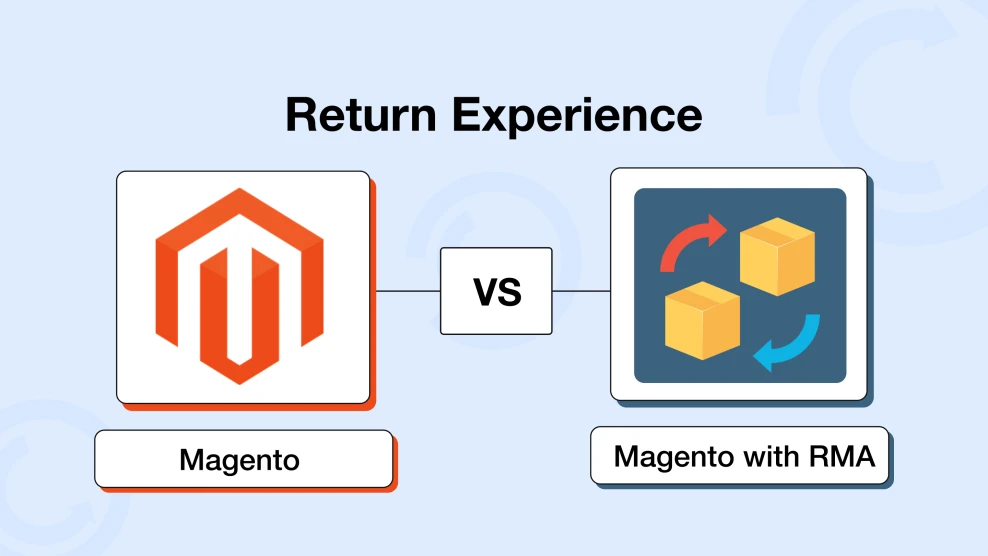Magento 2 Cache Management: Benefits, Problems, Solutions
-
 Roman Lobovskyi
Roman Lobovskyi
- E-commerce Tips & Best Practices
- Feb 25, 2025
- 10 min read
According to statistics, one second of page load can reduce site conversion by up to 20%. With significant waiting time for a response from the server, a person might give up waiting and opt for another resource. Every moment matters, especially relating to online stores. Page caching helps optimize this process.
Today, we will cover the working principle of cache in Magento, different ways of warming up pages, their advantages, and impact on SEO. You will also learn when to use additional modules for cache warming and how they can affect the store’s work rate.
Table of Contents
- How Magento cache works
- How to distinguish between page loads from the server and cache
- How cache usage impacts online business
- How the default Magento cache system works
- How pages are warmed using a Magento 2 Cache Warmer
- Conclusion
How Magento cache works
When someone visits a website, their opinion is significantly affected by how fast the pages load—it is much easier for a high-speed resource to gain user sympathy. Various tools and approaches serve to reduce page load time: code optimization, image compression, and caching play an important role in the fight for seconds.
For example, if the pages are static, as in the early years of the Internet, when the page is a mere HTML document with already written content, the issue of caching is not relevant. Given a request for this page, the finished document is immediately returned. No challenging operations, no processing.
In modern systems, including Magento, pages are dynamic. That is, ready-made full-fledged pages are not directly stored on the server. If we don’t imply individual cases of ready-made landing pages, this page is assembled from components: something is drawn in blocks, some data requests are made to the database, and certain calculations are performed. Then everything is collected on one page and sent out.
Even if each of these operations takes a little time, they sum up and increase the page loading time.
How to distinguish between page loads from the server and cache
To solve the problem of enhanced page load time, caching is used. This is saving a copy of the finished page in the cache. Consequently, when a person requests a page, they do not have to wait for it to be assembled from scratch.
How noticeable is the difference?
Page loading speed is affected by various parameters: server load, volume of content, number of images, scripts, database requests, and their complexity.
However, all these operations are not performed when a page is cached. The cache system simply checks whether the page is in the cache and, if so, immediately returns it. As a result, the difference in loading time can be tenfold!
You can easily verify this in practice. Open developer tools in the browser: Developer Tools > Network and load the page. If you are sure it is not cached, then opening it for the first time, you can see the download time—the Time to First Byte (TTFB) parameter.
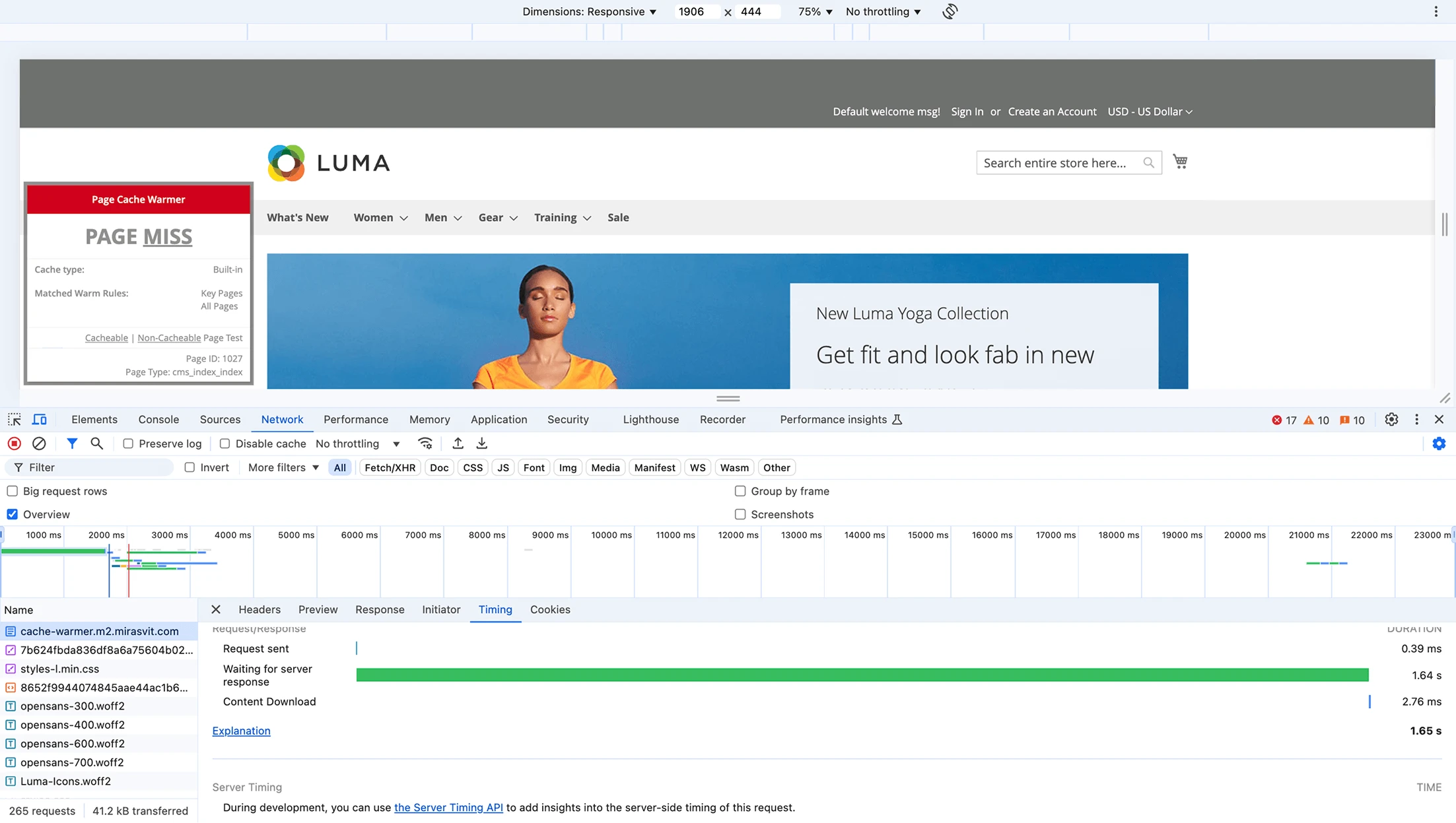
The second time, the page will be loaded from the cache, so the time for all subsequent downloads will be shorter.
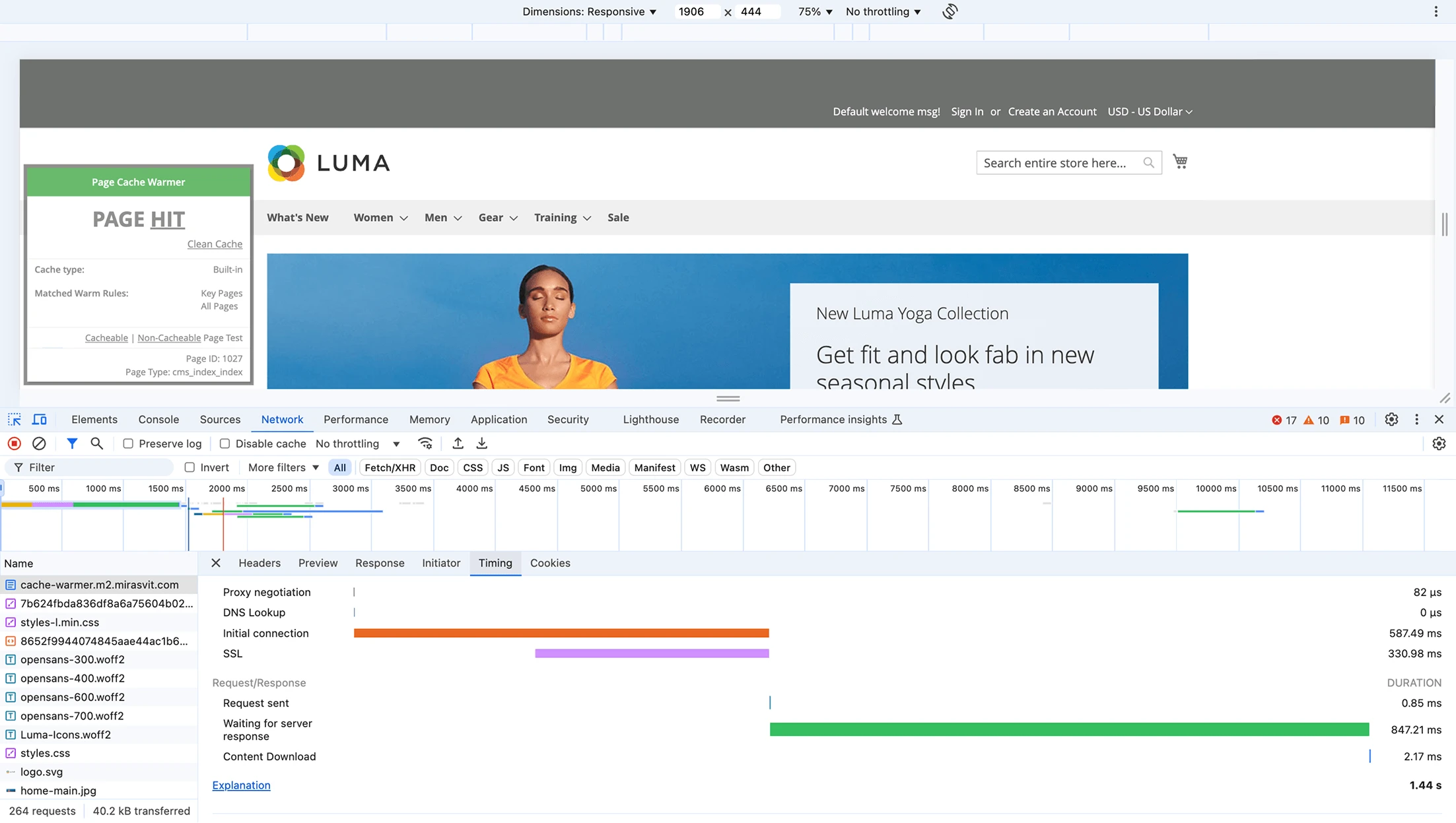
Thus, you can clearly see the difference in loading between non-cached and cached pages from the server. It will be really noticeable.
How will this affect the overall performance of the store? Let's take a look.
How cache usage impacts online business
Fast loading of online store pages with caching provides several valuable advantages.
Time savings through faster loading
This is the main advantage, and all others are actually its outcome. First, the page load time is shorter, which reduces the risk of lost conversions. Second, it improves the impression of site visitors (user experience), allowing them to quickly move from page to page in search of the necessary data. Third, page caching helps significantly reduce the load on the server.
Improved SEO performance
Performance is a separate part of site evaluation for search results. Load speed affects many of the key web metrics that this score is based on.
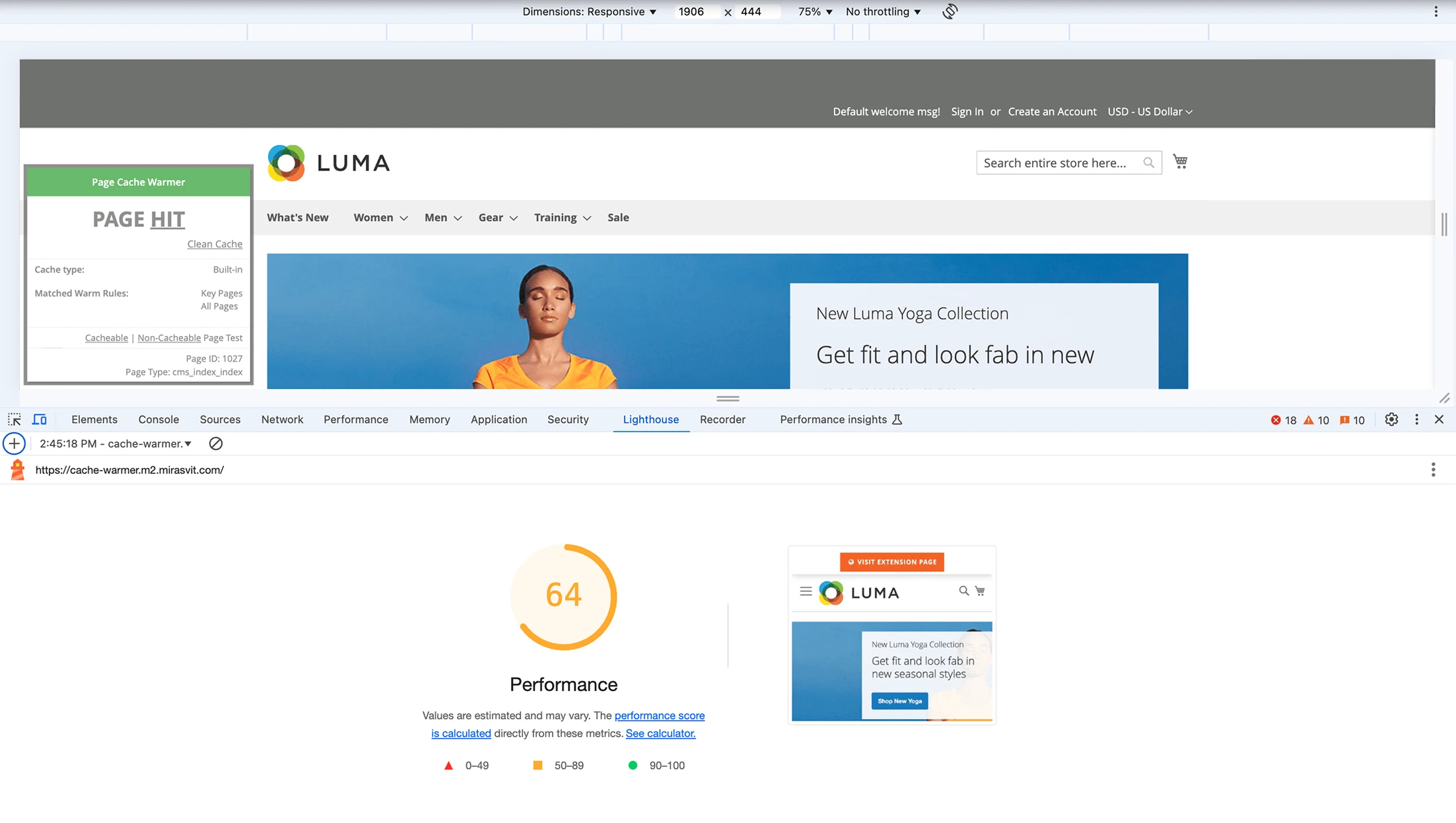
For example, the SEO ranking index increases, which positively affects the position of the online store site in search results.
Download speed directly affects the following parameters:
- Time to display the first content. The first part of the assessed time is always the Time to First Byte (TTFB). The smaller it is, the less the overall time of this metric and the total score, respectively.
- Speed index. The faster the page loads, the speedier the search bot will open it, scan it, and move on to another page. The more pages this site has cached, the faster the page scanning for the entire site will be.
Better website availability
Stable access to the online store is another important advantage of using a cache.
Imagine that the server stopped working and cannot build pages for a short period of time. However, the visitor will still manage to see the cached pages of your store instead of the server error notification.
That is, the client will not even notice that the page is temporarily unavailable; they will continue to use the site. Perhaps with certain restrictions, but they will still be able to get all the needed information, browse pages, and choose products. The server will resume working during this time.
How the default Magento cache system works
So, we've defined the bonuses provided by page caching. Now, let's examine the main aspects of the default Magento Cache system and how you can influence its effectiveness. The first version of Magento did not have a built-in page cache. If the owners of online stores wanted to speed up the website in this way, they had to use third-party modules. The second version of Magento already has a separate type of cache: Full Page Cache, which uses the built-in cache system by default.
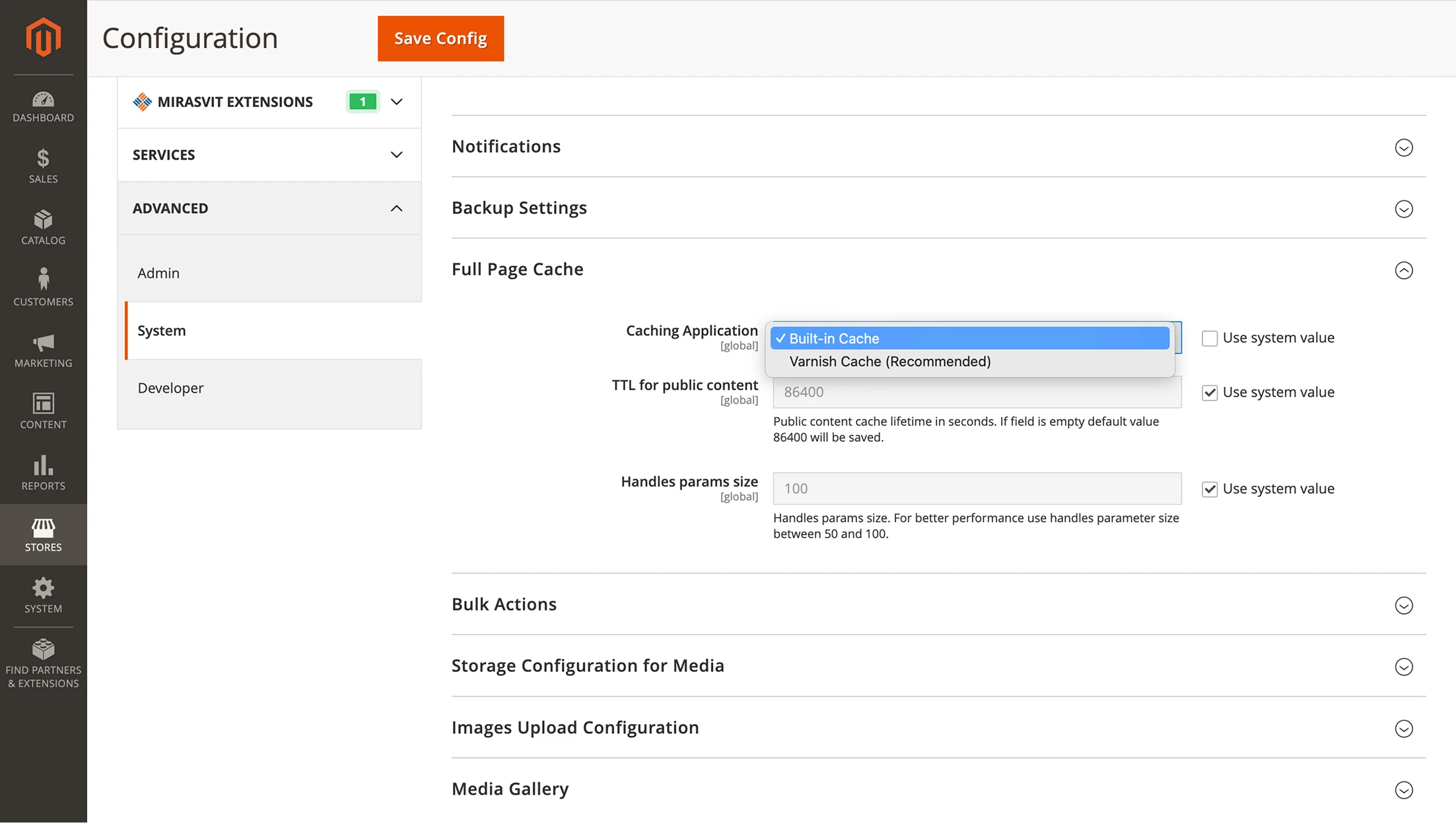
Its peculiarity lies in the filing nature. Thus, cached versions of pages are stored in the file system, so this caching system may run slower than others.
This can be a good option if you have a small or medium-sized online store where changes do not happen very often. If possible, Magento recommends using an external cache system like one of the fastest—Varnish. However, there are nuances here: it needs the correct setup.
Anyway, you can try different options—Built-in, Varnish, Redis (a variant of an external cache system), etc.—and choose the one that will speed up your store work and make it more stable.
How long cached pages stay and how to flush the Magento cache
Magento has a setting called TTL (Time to Live) that controls how long the page cache is stored, which can be set in the admin panel. By default, it is 24 hours. When this time expires, the system removes the entry from the cache, and the page is built and cached again. This is normal practice because the cache is temporary storage for data.
If a product is changed and the changes are saved, Magento 2 automatically clears the cache of all pages with that product. Then they are built again, now with relevant information.
How page caching works for different user groups
Cached versions of pages have identifiers. The main one is the page URL, but other parameters (the so-called HTTP context) also affect the uniqueness of a page in the cache.
A page with a URL can have multiple cache entries depending on these parameters. They include a customer group, currency, taxes, etc.
Third-party modules, such as the page speed optimizer, can add their parameters to the HTTP context if pages must have different cached versions depending on certain criteria.
For example, there can be different design themes for the desktop and mobile versions. Eventually, each format in the cache will have separate page entries.
For a page with different combinations of parameters, according to which the data on the page may diverge (currency, tax classes, different groups of users, etc.), separate entries are created in the cache. Thus, the store visitor receives not general but relevant information.
A page will be cached separately for each customer group with different levels of access. If some group does not have access to part of the information, it will not be present at the stage of building the page by the server. Then, this page will be served from the cache to any visitors inside this group.
How to exclude pages from Magento cache management
Not all pages in Magento need to be cached. For example, almost all content on the shopping cart or checkout pages is unique for each visitor and session and is constantly changing. Therefore, it makes no sense to create their copies in the cache.
How to exclude them from caching? Just add the cacheable="false" attribute to any block of your page’s XML layout, and it will consequently become non-cacheable. The presence of at least one uncached block makes the entire page uncached.
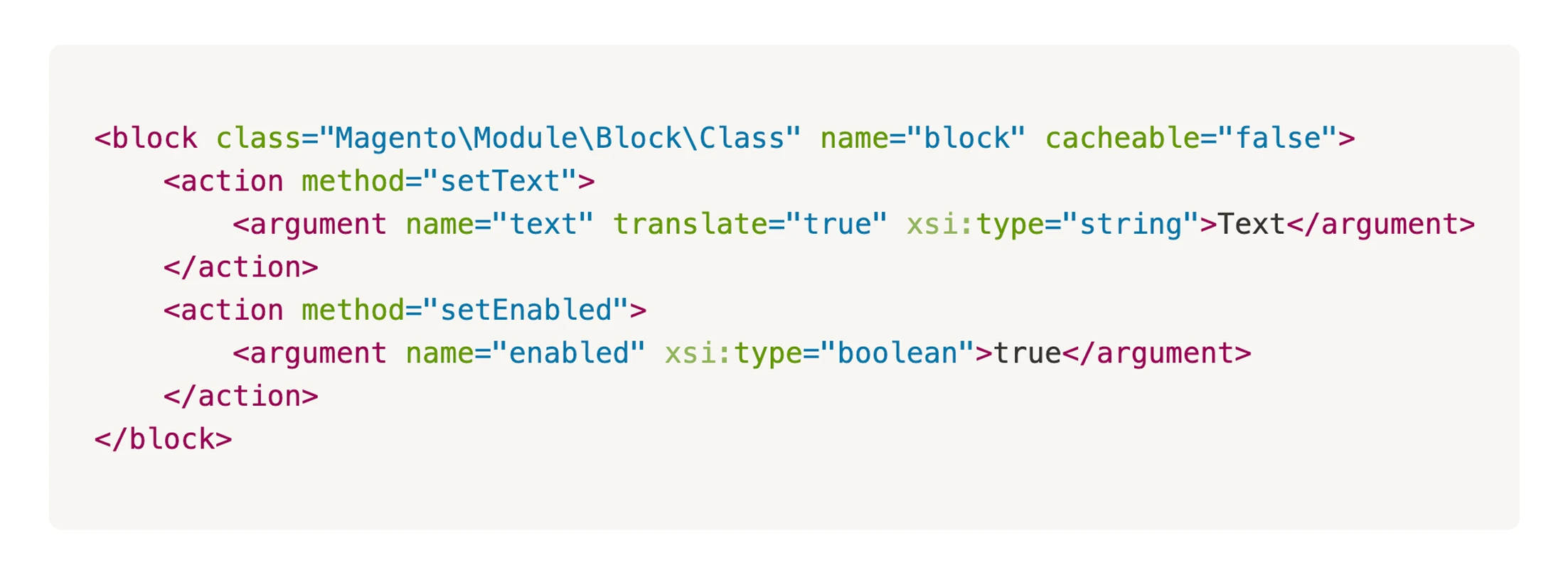
We have examined the main principles by which the default cache system in Magento works. Is it enough for the functioning of an e-commerce business? Yes, especially a small one where the pages don't change often. However, the caching speed will not be very high.
How to optimize this process? The solution is to warm cache—the process when some utility, service, or module forces a page to be cached before a real user visits it in the browser.
Let's take a closer look at its working principle.
How pages are warmed using a Magento 2 Cache Warmer
If you want online store users to load pages faster, you can use cache warmers—third-party modules, console or server utilities, or web services running on the basis of Magento.
A cache warmer handles the initial request phase by simulating a visit. As a result, the cache chain looks like this:
- The module sends a request to the server.
- The page is being built and cached.
- Real requests from the browser or from search bots receive an already cached page, which significantly shortens its download time.
In other words, such a tool collects site pages (or works on a prepared list of pages) and warms them up in the cold cache.
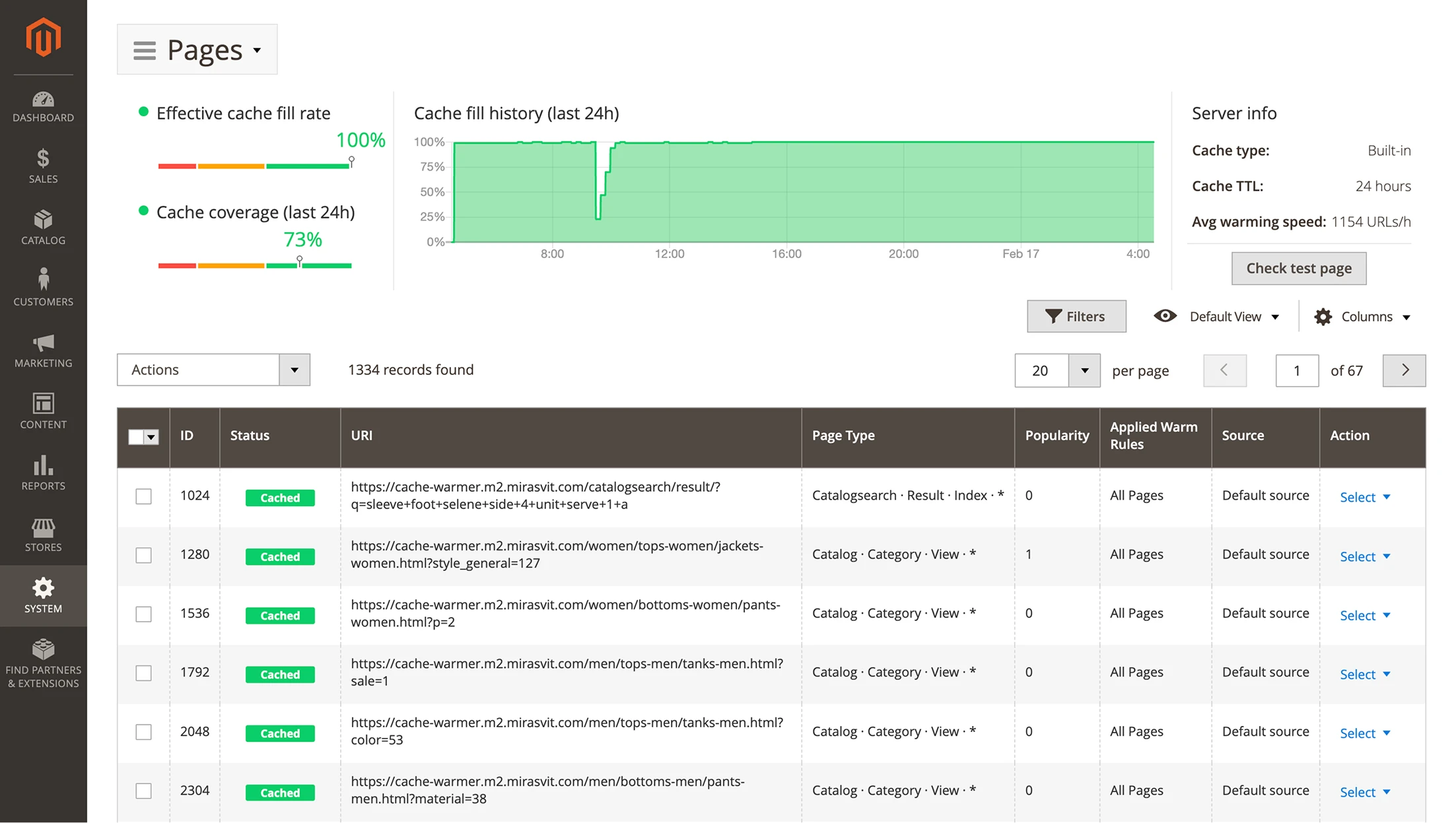
If a page is cleared from the cache, the latter should pick it up on time and re-cache it for a repeated update.
Therefore, a cache warmer significantly enhances the loading speed for real visitors. Since the number of operations on the server’s behalf decreases, the waiting time for the user is notably reduced. Subsequently increases the level of customer satisfaction and store conversion.
Of course, in addition to this basic function, cache warmers can provide extra benefits. We will provide examples based on our module.
Magento 2 Full Page Cache Warmer by Mirasvit: additional features to boost performance
Full Page Cache Warmer significantly increases page loading speed and minimizes server load.
The module works with any cache system supported by Magento: built-in file cache, Varnish (recommended by Magento), Redis, LiteMage FPC, and FishPig.
What are its advantages, and what additional opportunities can it provide to an e-commerce business?
1. Flexible Magento cache management.
You can adjust which pages should be warmed up first. It could be high-traffic content, top-buy product pages, or key landing pages. Due to this, the cache always contains the most important data, which minimizes loading delays. You can also completely exclude certain pages from the cache warm-up queue. These can be pages:
- Categories with a large number of applied filters.
- With marketing GET parameters.
- All pages of a certain type (for example, each related to the shopping cart).
2. Performance and cache optimization
Full Page Cache Warmer helps avoid server overload due to flexible performance tuning. It provides the ability to control the frequency of requests, launch caching at times of low load, and efficiently use the cache for multi-stores, avoiding duplicate copies of pages. This reduces the load on the server and ensures a stable download speed.
3. Automatic monitoring and advanced caching.
The extension automatically monitors cache clearing and instantly warms up pages so that users and search bots always get relevant content. It also allows you to cache those page elements the standard Magento system ignores, which additionally speeds up their loading.
Thanks to these capabilities, Full Page Cache Warmer not only warms the cache but also makes the process as convenient, controlled, and productive as possible. This is crucial for large stores, where unmanaged caching can create additional load or omit important pages.
Conclusion
Page loading speed is vital for an online store since even a second delay can affect conversion. Magento has built-in caching, but its capabilities may not suffice, especially for large projects.
Cache warmers allow you to warm up the cache in advance, reducing the load on the server and ensuring fast loading of pages. Modules like Magento Full Page Cache Warmer not only automate this process, but also give you more control—allowing you to prioritize, balance resources, and efficiently cache dynamic content.
As a result, pages load faster, the server works more stably, and users get a better experience without expectations.
Magento 2 store loads quickly only if its pages are in the cache. Our extension automatically adds pages to the cache and thus, speeds up your store!
Whenever your customer or Google visits a page, its most recent variant will be loaded in a fraction of seconds from the cache.
This extension introduces a unique robot designed to monitor cache status. Once the cached page is cleared, the robot visits this page and warms up the cache for it!



